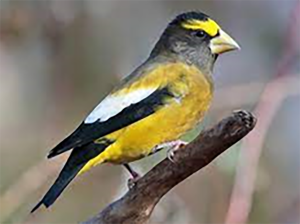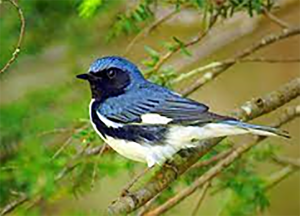 Have you seen new birds in your yard recently? There is a shift in our bird population in the winter. Some of our favorite summer birds migrate south while others, often the same species, remain to winter with us. Some of the more northern bird varieties that fly south stop to winter in this area. Add to those the few that go off course during their migration and present us with unique opportunities to briefly spot a bird not known around here.
Have you seen new birds in your yard recently? There is a shift in our bird population in the winter. Some of our favorite summer birds migrate south while others, often the same species, remain to winter with us. Some of the more northern bird varieties that fly south stop to winter in this area. Add to those the few that go off course during their migration and present us with unique opportunities to briefly spot a bird not known around here.
Robins are one of the birds whose population actually increases in the winter although they stay mostly in the woods rather than on our lawns. If you forget to take down your hummingbird feeder you might spot a rufous hummingbird as they are increasingly found here during the winter. They can tolerate much colder weather than the ruby-throated hummingbirds.
Some of the less common winter visitors to feeders are the evening grosbeak, pine siskin, common redpoll, and purple finch. Patrick County is more likely to see the strikingly colored evening grosbeaks than those who live in central or eastern Virginia. Cedar waxwings, often in large flocks that might include robins, common grackles, rusty grackles, and starlings, gather on dogwood trees to strip the berries in late fall.
What do these birds eat in the wild?
During the winter wild birds forage for seeds from tall grasses and harvested grain fields. They eat dried fruit on trees and shrubs, and insects in fallen leaves and on plants. Blue jays eat acorns and hickory nuts, crows and ravens will clean up roadkill.
 We can help by not cutting back our flower beds or removing all those fallen leaves. The vegetation often hides insects, grubs, and larva that songbirds will devour. Brush piles offer winter protection for wild birds, as does an old live Christmas tree tossed near a bird feeder. Blue Jays, Chickadees, Titmice and Nuthatches will hide their food in the brush piles. Leaving hedgerows and rough areas at the edge of woods provides both food and cover. Don’t mow fallow fields until spring for the same reason. Many of the native fall asters and sunflowers provide quantities of seed. Joe Pye Weed, New York Iron Weed, Yellow Wingstem are just a few.
We can help by not cutting back our flower beds or removing all those fallen leaves. The vegetation often hides insects, grubs, and larva that songbirds will devour. Brush piles offer winter protection for wild birds, as does an old live Christmas tree tossed near a bird feeder. Blue Jays, Chickadees, Titmice and Nuthatches will hide their food in the brush piles. Leaving hedgerows and rough areas at the edge of woods provides both food and cover. Don’t mow fallow fields until spring for the same reason. Many of the native fall asters and sunflowers provide quantities of seed. Joe Pye Weed, New York Iron Weed, Yellow Wingstem are just a few.
Planting native fruit and seed-bearing trees and shrubs will increase the natural food supply. Pine, oak, mulberry, dogwood, blackgum, wild cherry and holly all provide winter fruit or drupes for the birds. So do shrubs such as elderberry, blackberry, blueberry, Virginia creeper, grape, wax myrtle, and even poison ivy. Tall native grasses like foxtail and switch grass provide seeds, as do pokeweed, ragweed, smartweed, and native sunflowers.
Feeding Winter Birds
Black-oil sunflower seeds attract the widest variety of birds. These seeds have a high meat-to-shell ratio, they are nutritious and high in fat, and their small size and thin shells make them easy for small birds to crack. Striped sunflower seeds are larger and have a thicker seed coat that many birds can’t crack.
Cheap bags of birdseed contain fillers such as red milo and cracked corn which most birds will not eat.
Remove wet seed and scrub feeders after a hard rain. Moldy seed will sicken the birds.
Toss some seed below patio tables or deck edges so ground-feeding birds can forage easily.
Clean off feeders immediately after snowstorms so birds can quickly replenish their energy.
 Birds will use their oil glands to spread the oil over their feathers to keep them insulated from the cold wind and air.
Birds will use their oil glands to spread the oil over their feathers to keep them insulated from the cold wind and air.
Suet – High-energy suet is probably one of the most important offerings you can provide for your birds during fall & winter. Suet is a quick source of energy and a great way to substitute for the protein-rich insects that are hard to find in winter. Use wire cage feeders to hold suet cakes.
Water – A source of unfrozen, fresh water is vital to birds in winter. Offering fresh water in your backyard will double the amount of birds you can enjoy during these colder months. Birds need water to preen and clean their feathers. This helps insulate their bodies from the harsh weather. Invest in a heated birdbath or heating element for your existing birdbath. At the very least, place a small bowl of warm water out each day for your birds.
Fruit – Birds may appreciate cut-up fruit (grapes, sliced citrus, apples or bananas) and frozen berries in the winter, as well. You can put these in a shallow bowl on a platform feeder.
Bluebird Crumbles You Can Make
Almost all birds that eat insects during the summer will enjoy these crumbles in the winter and spring.
Easy to make and stores for months. Serve in a covered container, like a milk jug with a hole cut out so the crumbles don’t get wet. Throw wet crumbles away.
1 part Lard
1 part Peanut Butter
2 parts Sunflower Hearts (ground fine in food processer or blender, Tractor Supply)
2 parts Old Fashioned Oatmeal (ground fine in food processer or blender)
2 parts Corn Meal (NOT self-rising)
Melt lard and peanut butter, add to dry ingredients. Mix well, let sit for a few hours to absorb liquid. Crumbles should form a ball in your fist but break apart if poked. Store in a cool, dry pace.



